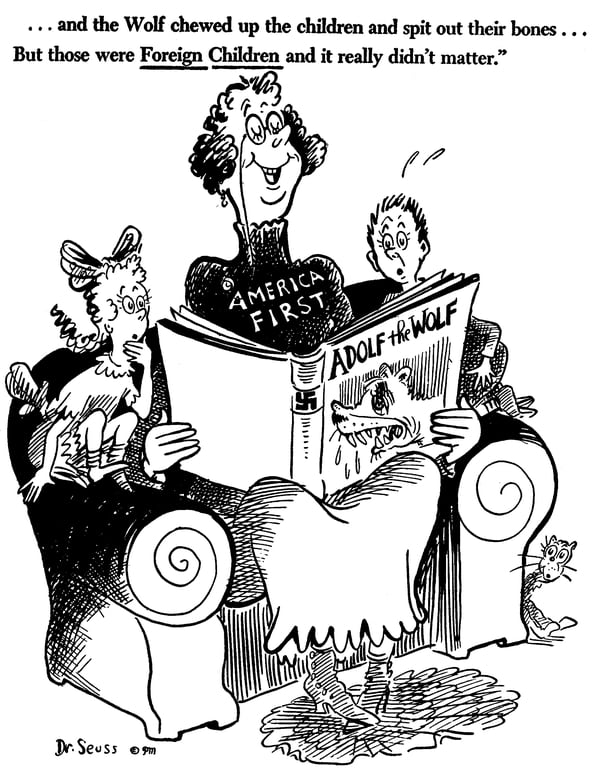Historian uncovers Dr. Seuss's complicated history as a political cartoonist
He was progressive in some ways but not when it came to his depiction of Japanese people, says Richard Minear


Richard Minear was worried when he first met Audrey Geisel.
It was 2001, and the historian and author was about to give a presentation on Geisel's late husband Theodor Seuss Geisel — better known as the beloved children's author and illustrator Dr. Seuss, who would have celebrated his 116th birthday this week.
It was two years after the release of his book Dr. Seuss Goes to War, which detailed his lesser-known career as a political cartoonist, who tackled issues such as racism, antisemitism and Adolf Hitler.
"I was a little bit concerned going in," Minear said. "She showed up and sat in the front row, and I didn't pull my punches in the presentation."
Geisel approached Minear after the presentation. She said it was "fascinating" and admitted that she had no idea about her late husband's past.
"For her in 2001 not to know about this aspect of Seuss startled me," he told Day 6 host Brent Bambury.

But Geisel, who died in 2018, was not alone.
For many generations of readers, Seuss was known for imaginative and colourful books like The Lorax and The Cat in the Hat, not tackling hot-button political topics.
Some progressive stances, but racist Japanese depictions
According to Minear, Seuss first started drawing political cartoons for a "liberal left New York newspaper" called PM from 1941 to 1943.
"He was actually drawing almost a cartoon a day," he said.
Europe was in the midst of the Second World War. Seuss, who was of German descent, focused a number of his early cartoons on related topics, such as Hitler and anti-Semitism.
"What stands out in the early cartoons is that he takes a strong stand against anti-Semitism," he said. "That wasn't common among mainstream American newspapers ... so that's a major bright point of his legacy."
Seuss was also critical of non-interventionists, including the America First Committee, a non-partisan pressure group who opposed intervening in the war.
One of his most famous political cartoons depicts a mother reading a book about Adolf the Wolf, an obvious satire of Hitler.

Minear also pointed to Seuss's sympathetic view of black Americans with one image dated 1942.
"He has one cartoon of a U.S. War Industry building, surrounded by a maze," he said. "And if you enter the door, there's no way you can get to the factory. And over the door it says 'Negro Job Hunters Enter Here.'"

Unfortunately, Minear said, Seuss did have an "Achilles heel": stereotypical and offensive portrayals of Japanese people.
Unlike his diverse and varied portrayals of black Americans and Jews, Seuss used a "cookie-cutter face with a moustache and glass-bottle eyeglasses" to depict Japanese citizens and Japanese Americans, Minear said.
"It's a very grim, very unhappy story.... Those cartoons are racism barely concealed."
He described one specific cartoon published days before the internment of Japanese Americans in February 1942.
"He had one cartoon that showed Japanese Americans — or his stereotypical Japanese — on the west coast ... marching down toward a bungalow," he said.
"The guy in front of the bungalow is handing out bricks of TNT, and there's a fellow on the roof with a spyglass pointed across the Pacific."

Minear suggested that Seuss likely had "very little contact, if any with Japanese or Japanese Americans," which might explain their portrayal.
"These cartoons certainly demonstrate that ignorance," he said.
Nonetheless, Minear says these "racist depictions" are a teachable moment.
"Even Dr. Seuss — liberal and good on anti-black sentiment, good on antisemitism — even this guy was totally blind about the Asian side of the picture," he said.
Impact on his post-war works
Not long after publishing his final political cartoon in January 1943, Seuss joined the United States Army. With the rank of captain, he commanded the Animation Department of the Air Forces' First Motion Picture Unit.
There, he wrote propaganda and military training films including Design for Death, which won an Academy Award, and the animated Private Snafu series, which starred Mel Blanc.
Seuss's political themes also stretched into his post-war children's books. Minear points out the clear references to Japan in Horton Hears a Who, which was published after Seuss visited Japan in 1953.
"[The passage] 'A person's a person no matter how small'" was "clearly a reference to Japan," he explained.
"And, there's a [vulture] named Vlad Vladikoff [who represents] the Russians, and their monkeys, presumably representing Red China."
He also mentions Yertle the Turtle, who initially "had a Hitler moustache," and the Sneetches from The Sneetches and Other Stories, who are a commentary on antisemitism due to the stars on some of their bellies.
Seuss included these themes in his books because he believed that children's literature was an extension of satire.
"Children's literature as I write it and as I see it is satire to a great extent – satirizing the mores and the habits of the world," he said.
Written and produced by Mouhamad Rachini. To hear more from Richard Minear, download our podcast or click Listen above.
You can access all of Dr. Seuss's political cartoons by visiting UC San Diego's Special Collections & Archives website.